
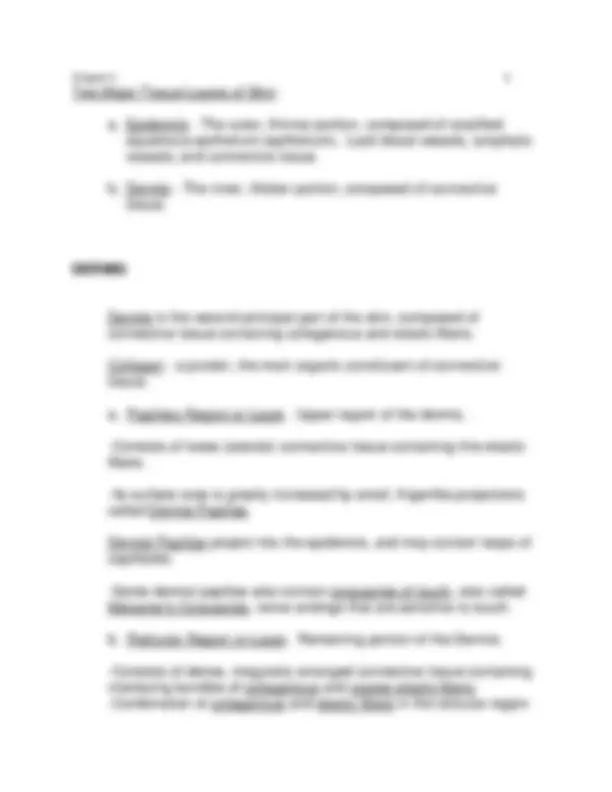
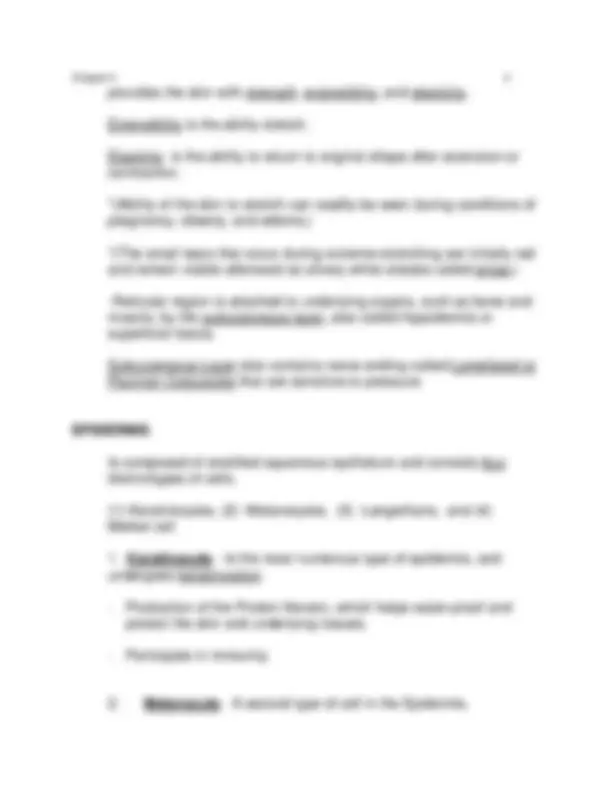
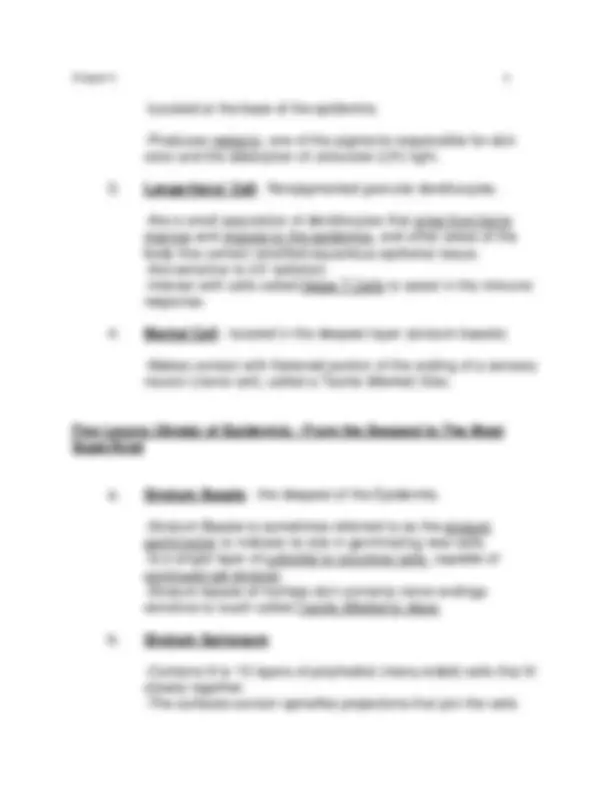
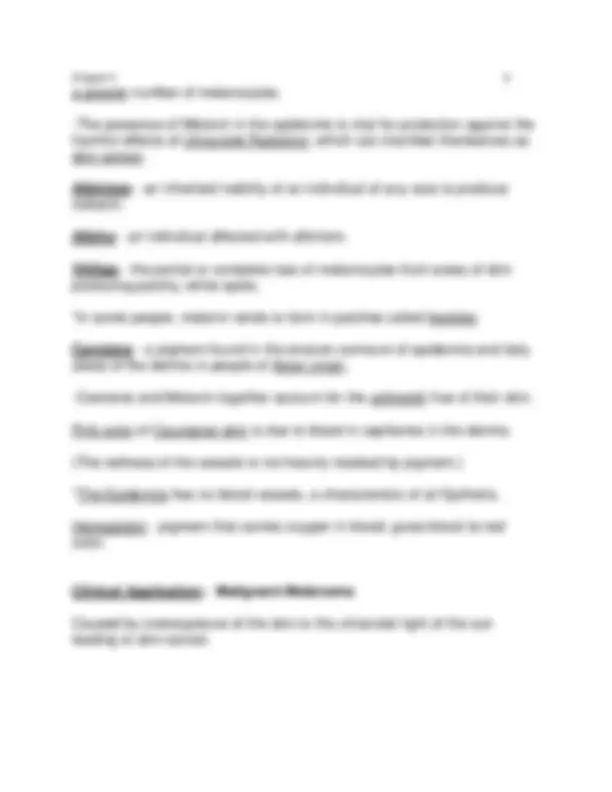
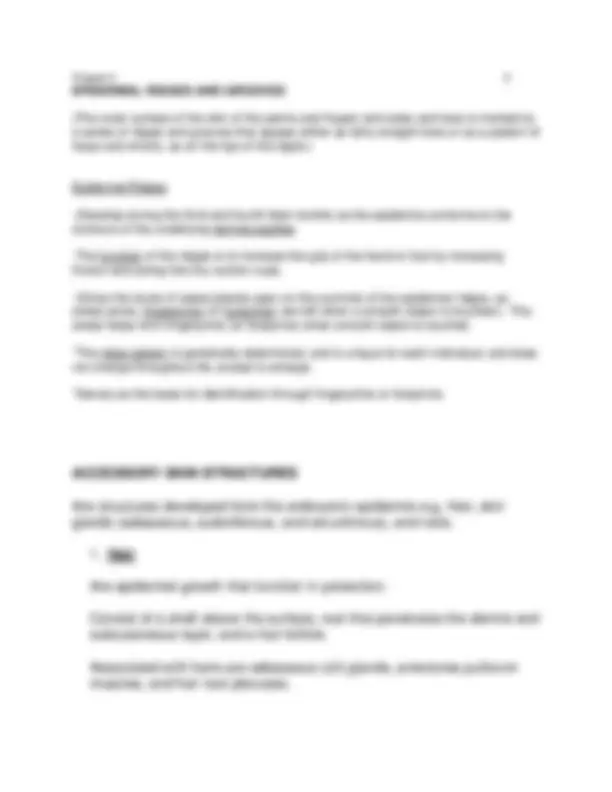
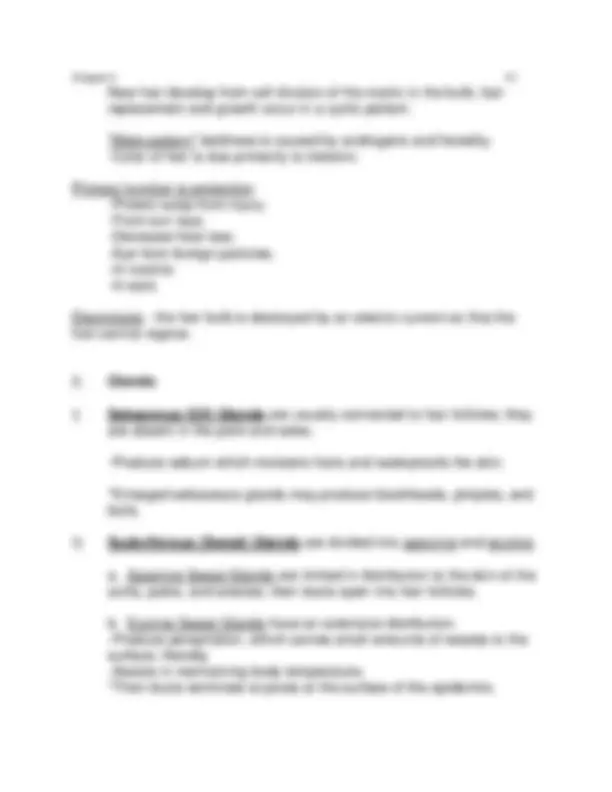



Study with the several resources on Docsity

Earn points by helping other students or get them with a premium plan


Prepare for your exams
Study with the several resources on Docsity

Earn points to download
Earn points by helping other students or get them with a premium plan
Community
Ask the community for help and clear up your study doubts
Discover the best universities in your country according to Docsity users
Free resources
Download our free guides on studying techniques, anxiety management strategies, and thesis advice from Docsity tutors
Chapter 5 Marieb Human Anatomy and Physiology Material Type: Notes; Professor: Gunn; Class: Anatomy and Physiology; Subject: Biology; University: University of Texas - Pan American;
Typology: Study notes
1 / 13

This page cannot be seen from the preview
Don't miss anything!








Integumentary System – Consists of the skin and accessory structures such as hair, nails, and glands.
Integument means covering.
Overview of the Integumentary System
Major Functions of the Integumentary System
Hypodermis – Attaches the skin to the underlying bone and muscles and supplies it with blood vessels and nerves.
Main types of cells within the hypodermis are fibroblast, adipose cells, and macrophages.
Subcutatneous tissue of Superficial fascia – Hypodermis that is not part of the skin.
Skin is one of the largest organs of the body in terms of surface area and weight.
Dermatology - is the medical specialty that deals with the diagnosis and treatment of skin disorders.
provides the skin with strength, extensibility, and elasticity.
Extensibility is the ability stretch.
Elasticity is the ability to return to original shape after extension or contraction.
*(Ability of the skin to stretch can readily be seen during conditions of pregnancy, obesity, and edema.)
*(The small tears that occur during extreme stretching are initially red and remain visible afterward as silvery white streaks called striae.)
-Reticular region is attached to underlying organs, such as bone and muscle, by the subcutaneous layer, also called Hypodermis or superficial fascia.
Subcutaneous Layer also contains nerve ending called Lamellated or Pacinian Corpuscles that are sensitive to pressure.
Is composed of stratified squamous epithelium and consists four distincttypes of cells.
(1) Keratinocytes, (2) Melanocytes, (3) Langerhans, and (4) Merkel cell
-Located at the base of the epidermis.
-Produces melanin, one of the pigments responsible for skin color and the absorption of ultraviolet (UV) light.
-Are a small population of dendrocytes that arise from bone marrow and migrate to the epidermis, and other areas of the body that contain stratified squamous epithelial tissue. -Are sensitive to UV radiation. -Interact with cells called Helpe T Cells to assist in the immune response.
-Makes contact with flattened portion of the ending of a sensory neuron (nerve cell), called a Tactile (Merkel) Disc.
Five Layers (Strata) of Epidermis - From the Deepest to The Most Superficial
a. Stratum Basale - the deepest of the Epidermis.
-Stratum Basale is sometimes referred to as the stratum germination to indicate its role in germinating new cells. -Is a single layer of cuboidal to columnar cells capable of continued cell division. -Stratum basale of hairless skin contains nerve endings sensitive to touch called Tactile (Merkel's) discs.
b. Stratum Spinosum
-Contains 8 to 10 layers of polyhedral (many-sided) cells that fit closely together. -The surfaces contain spinelike projections that join the cells
Thick Skin – Has all five epithelial strata, and the stratum cornuem has many layers of cells.
Found in areas subject to pressure or friction, such as palm of the hands, the soles of the feet, and the fingertips.
Thin Skin – Covers the rest of the body and is more flexible than thick skin.
Color of Skin is due to:
i Melanin - a pigment in the epidermis; ii Carotene - a pigment mostly in the dermis; and iii Blood - in capillaries in the dermis.
Melanin is synthesized in cells called Melanocytes.
Melanocytes - are produced from Melanoblasts.
-Are most plentiful in the mucous membranes, penis, nipples of the breasts and the area just around the nipples (areola), face, and extremities.
-Melanin gives color to the skin. Varies skin color from pale yellow to black.
-The amount of Melanin (black pigment) accounts for the color differences among the races.
*(Since the number of melanocytes is about the same in all races, differences in skin color are due to the amount of pigment the melanocytes produce and disperse.)
*-That is, individuals with darker skin possess more active melanocytes, not
a greater number of melanocytes.
-The presence of Melanin in the epidermis is vital for protection against the harmful effects of Ultraviolet Radiation, which can manifest themselves as skin cancer.
Albinism - an inherited inability of an individual of any race to produce melanin.
Albino - an individual affected with albinism.
Vitiligo - the partial or complete loss of melanocytes from areas of skin producing patchy, white spots.
*In some people, melanin tends to form in patches called freckles.
Carotene - a pigment found in the stratum corneum of epidermis and fatty areas of the dermis in people of Asian origin.
-Carotene and Melanin together account for the yellowish hue of their skin.
Pink color of Caucasian skin is due to blood in capillaries in the dermis.
(The redness of the vessels is not heavily masked by pigment.)
*The Epidermis has no blood vessels, a characteristic of all Epithelia.
Hemoglobin - pigment that carries oxygen in blood; gives blood its red color.
Clinical Application: Malignant Melanoma
Caused by overexposure of the skin to the ultraviolet light of the sun leading to skin cancer.
New hair develop from cell division of the matrix in the bulb; hair replacement and growth occur in a cyclic pattern.
"Male-pattern" baldness is caused by androgens and heredity. -Color of hair is due primarily to melanin.
Primary function is protection: -Protect scalp from injury. -From sun rays. -Decrease heat loss. -Eye from foreign particles. -In nostrils -In ears
Electrolysis - the hair bulb is destroyed by an electric current so that the hair cannot regrow.
i) Sebaceous (Oil) Glands are usually connected to hair follicles; they are absent in the palm and soles.
-Produce sebum which moistens hairs and waterproofs the skin.
*Enlarged sebaceous glands may produce blackheads, pimples, and boils.
ii) Sudoriferous (Sweat) Glands are divided into apocrine and eccrine.
a. Apocrine Sweat Glands are limited in distribution to the skin of the axilla, pubis, and areolae; their ducts open into hair follicles.
b. Eccrine Sweat Glands have an extensive distribution. -Produce perspiration, which carries small amounts of wastes to the surface; thereby -Assists in maintaining body temperature. *Their ducts terminate at pores at the surface of the epidermis.
iii) Ceruminous Glands are modified sudoriferous glands that secrete cerumen.
-Are found in the external auditory meatus.
-Nails are hard, keratinized epidermal cells over the dorsal surfaces of the terminal portions of the fingers and toes. -The principal parts of a nail are the body, free edge, root, lunula, eponychium (cuticle), and matrix. -Cell division of the matrix cells produces new nails. *Functionally, nails help us to grasp and manipulate small objects in various ways and provide protection against trauma to the ends of the digits.
(If environmental temperature is high, skin receptors sense the stimulus (heat) and generate impulses that are transmitted to the brain. The brain then causes the sweat glands to produce perspiration. As the perspiration evaporates, the skin is cooled.)
a. First-degree burn involves only the surface epidermis.
b. Second-degree burn involves the entire epidermis or varying portions of the dermis, and skin functions are lost.
*First-and second-degree burns are collectively referred to as Partial- thickness burns.
c. Third-degree burn or Full-thickness burn involves destruction of the epidermis, dermis, and the epidermal derivatives, and skin functions are lost.
Methods for determining the extent of a burn:
a. The Lund-Browder b. The "Rule of Nines"
Note: *Medical Terminology associated with the integumentary system.